There are 20 species of native snakes in West Virginia. These snakes range from fossorial species like the Eastern Worm snake to semi-aquatic Water snakes such as the Queen snake. There are also several terrestrial species across the state, like the Northern Brown snake.
Most of these reptiles pose no danger to humans, but West Virginia is home to two venomous species; the Northern Copperhead and the Timber Rattlesnake. While the venom of the Northern Copperhead isn’t fatal to humans, a bite from a Timber Rattlesnake can kill if not treated immediately.
This list will help you to identify West Virginia’s diverse range of native snakes and can be used as a useful field herping guide. We’ve separated the list into different types of snake to help you find your way around quickly. We’ll also help you to identify and avoid West Virginia’s two venomous species.
Here are the 20 native species of snakes in West Virginia.
Table of Contents
Snakes in West Virginia
1. Northern Brown Snake
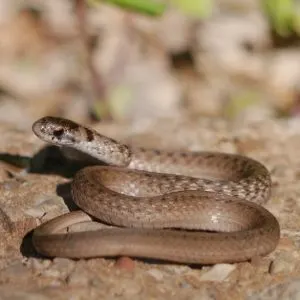
- Family: Colubridae
- Scientific Name: Storeria dekayi
- Other Names: Brown snake, Dekay’s Brown snake
- Adult Size: 10 to 15 inches (25 to 38 cm)
- Lifespan: 7 years
Northern Brown snakes are also known as Dekay’s Brown snakes and were named after James Dekay, an American zoologist. These scaled colubrids inhabit marshy or woodland areas but can also be seen in urban surroundings.
Northern Brown snakes have predominantly brown or gray scaly skin, with two columns of darker scales running down the length of their body. Their undersides range from brown to yellowish to pink.
These snakes are part of the Natricine group, which means that they give birth to live young. They eat a diet of mollusks such as earthworms, slugs, and snails. They specialize in sucking snails out from the safety of their shells with their mouths.
2. Smooth Earth Snake
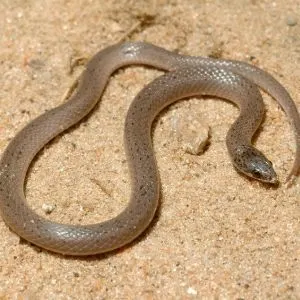
- Family: Colubridae
- Scientific Name: Virginia valeriae valeriae (Eastern Smooth Earth snake), Virginia valeriae pulchra (Mountain Smooth Earth snake)
- Other Names: Smooth Earth snake
- Adult Size: 7 to 15.5 inches (18 to 40 cm)
- Lifespan: 7 years
There are two subspecies of Smooth Earth in West Virginia; the Eastern Smooth Earth snake (Virginia valeriae valeriae) and the Mountain Smooth Earth snake (Virginia valeriae pulchra). These fossorial colubrids favor underground habitats in woods and forests. They are seen more often after heavy rain. Mountain Smooth Earth snakes favor higher elevations.
Eastern Smooth Earth snakes are a plain brown color with 15 rows of smooth scales on the tops of their bodies. They have white or yellowish underbellies and divided anal plates. Mountain Smooth Earth snakes are dark gray or reddish-brown with black patches. They have cream underbellies.
These smooth serpents are Natricine snakes, which means that they are live-bearers. Smooth Earth snakes primarily eat mollusks and small insects with softer bodies such as spiders.
3. Common Garter Snake
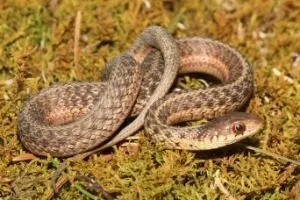
- Experience Level: Beginner to Intermediate
- Family: Colubridae
- Scientific Name: Thamnophis sirtalis
- Other Names: Garden snake, Gardener snake
- Adult Size: 18 to 48 inches (46 to 120 cm)
- Lifespan: 10 years
- Average Price Range: $15 to $45
Garter snakes are one of the most widespread species in the United States and can be kept fairly easily as pets. These common serpernts prefer woodland regions with small, slow bodies of water such as ponds or streams.
Common Garter snakes are vibrantly colored, with dark brown bodies and stripes ranging from red to orange or yellow. These thin snakes also have black checkered patterns in between their stripes. Their scales are keeled and they have a single anal plate.
Common Garter snakes can act defensively when handled, sometimes spraying musk to deter predators. However, they do quickly get used to handling and will calm down. These diurnal snakes will eat amphibians, fish, mollusks, and small mammals.
4. Common Ribbon Snake
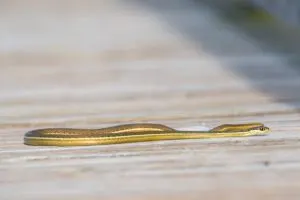
- Family: Colubridae
- Scientific Name: Thamnophis saurita
- Other Names: Eastern Ribbon snake
- Adult Size: 16 to 35 inches (40 to 90 cm)
- Lifespan: 10 years
Common Ribbon snakes are a type of Garter snake commonly found in West Virginia. These thin serpents prefer wetland habitats with a lot of lakes and ponds. This species is semi-aquatic and hunts while swimming in the water.
Common Ribbon snakes have dark brown keeled scales with three yellowish stripes running down their back and sides. This coloration helps them to blend in with vegetation underneath the water.
These aquatic hunters like to eat cold-blooded prey such as amphibians, fish, and insects. They do not retaliate when threatened, but will instead try to compress themselves close to the ground and hide among dense grasses.
5. Northern Rough Green Snake
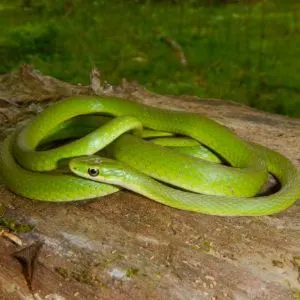
- Experience Level: Intermediate to Expert
- Family: Colubridae
- Scientific Name: Opheodrys aestivus aestivus
- Other Names: Grass snake, Green Grass snake
- Adult Size: 20 to 40 inches (50 to 100 cm)
- Lifespan: 6 to 8 years
- Average Price Range: $30
Northern Rough Green snakes are the nominal subspecies of the Rough Green snake. These arboreal serpents are excellent climbers and can be found in shrubs and trees across central and southwestern counties of West Virginia. Some have also been recorded in Jefferson County in the extreme northeast of the state, bordering Maryland and Virginia.
Northern Rough Green snakes are fairly common and are popular as pets. However, they can go off feeding if they feel uncomfortable, so they are recommended for experienced snake keepers. This species predominantly eats insects.
These beautiful snakes are unsurprisingly green, with white or yellowish undersides. They have rough, keeled scales and a divided anal plate. Once used to handling, Rough Green snakes can be pretty calm and docile.
6. Smooth Green Snake
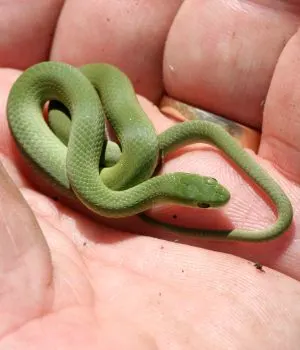
- Experience Level: Intermediate to Expert
- Family: Colubridae
- Scientific Name: Opheodrys vernalis
- Other Names: Grass snake
- Adult Size: 14 to 20 inches (35 to 50 cm)
- Lifespan: 6 years
- Average Price Range: Unknown
Smooth Green snakes are an arboreal species that inhabits meadows and wetland regions such as marshes. Unlike their Rough Green snake cousins, Smooth Green snakes have smooth scales without keels.
These serpents are often bright green with white or yellowish underbellies. They can be kept as pets, but are much rarer and harder to breed than Rough Green snakes. They do not like to be handled much but won’t react aggressively.
Smooth Green snakes eat insects such as ants and spiders as well as smaller mollusks. These snakes can secrete a foul-smelling musk if they do feel threatened.
7. Eastern Hog-nosed Snake
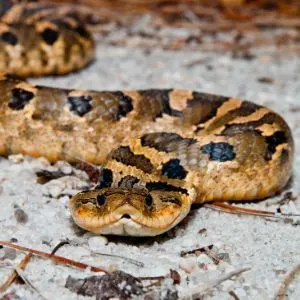
- Experience Level: Beginner
- Family: Colubridae
- Scientific Name: Heterodon platirhinos
- Other Names: Deaf Adder, Spreading Adder
- Adult Size: 20 to 40 inches (50 to 100 cm)
- Lifespan: 8 to 10 years
- Average Price Range: $120 to $200
Eastern Hog-nosed snakes are a popular species that are commonly kept as pets. They are relatively docile and their mild venom isn’t harmful to humans. These beloved colubrids are famous for their shovel-like snouts, which they use to poke attackers rather than biting them.
In the wild, Eastern Hog-nosed snakes inhabit grasslands and woodlands that have loose, sandy soils. They mainly eat amphibians such as frogs and toads. These prey animals are vulnerable to the Hog-nosed snake’s venom.
Eastern Hog-nosed snakes have light brown to yellowish-brown bodies with dark brown patterning. Their upturned snouts are their most well-known feature. They can be found in a variety of morphs as well, including some melanistic ones.
8. Common Kingsnake
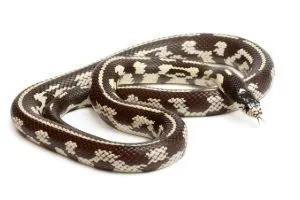
- Experience Level: Intermediate
- Family: Colubridae
- Scientific Name: Lampropeltis getula (Eastern Kingsnake), Lampropeltis nigra (Black Kingsnake)
- Other Names: Chain Kingsnake, Common Kingsnake
- Adult Size: 34 to 70 inches (88 to 178 cm)
- Lifespan: 15 to 25 years
- Average Price Range: $80 to $250
There are two subspecies of the Common Kingsnake that can be encountered in West Virginia; the Eastern Kingsnake (Lampropeltis getula) and the Black Kingsnake (Lampropeltis nigra). They can be found in a variety of habitats but prefer grasslands and woodlands with bodies of water such as canals or swamps.
Eastern Kingsnakes have dark black or blueish-black glossy scales with white ring-like patterns. Black Kingsnakes are almost a uniform black, with cream or yellow speckled markings, especially along their sides.
Black Kingsnakes also tend to be larger than Eastern Kingsnakes, between 58 to 70 inches (150 to 178 cm) compared to 34 to 60 inches (88 to 150 cm) for Eastern Kingsnakes.
These powerful snakes actually consume other snake species, even venomous snakes such as Copperhead vipers. They also eat smaller reptiles and mammals such as rodents.
9. Eastern Milk Snake
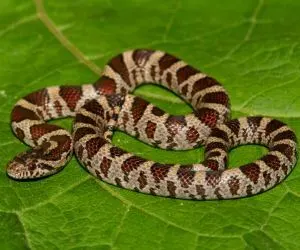
- Experience Level: Beginner
- Family: Colubridae
- Scientific Name: Lampropeltis triangulum triangulum
- Other Names: Checkered Adder, Common Milk snake
- Adult Size: 24 to 36 inches (61 to 90 cm)
- Lifespan: 15 to 20 years
- Average Price Range: $80 to $125
Milk snakes are one of the easiest pet snakes and are often recommended for beginners due to their manageable size and thin bodies. They are an active and beautifully colored nocturnal species.
Eastern Milk snakes are one of the most common subspecies of Milk snake. They have brown to red smooth scales with white bands edged in black.
Eastern Milk snakes can be found in both open spaces such as grasslands and prairies as well as forests and woodland areas. Milk snakes prey on rodents and smaller reptiles by hiding themselves under fallen leaves and other debris.
10. Northern Pine Snake
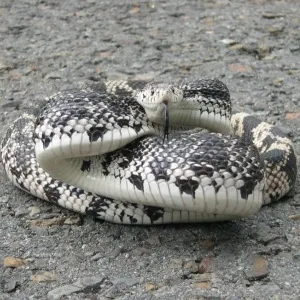
- Experience Level: Intermediate to Expert
- Family: Colubridae
- Scientific Name: Pituophis melanoleucus
- Other Names: Pine snake
- Adult Size: 48 to 90 inches (120 to 230 cm)
- Lifespan: 5 to 10 years
- Average Price Range: $170 to $200
Northern Pine snakes are thick, powerful large snakes found in West Virginia. These colossal colubrids are mainly encountered in pine forests, but will also inhabit grasslands and prairies as well. They can make a rattling sound through their throats and flatten themselves if caught off guard.
Northern Pine snakes are usually a drab brown or tan color to help them blend in with the forest floor. They have black to reddish-brown to brown markings. These snakes are long and thick, almost muscular, and have slightly pointed heads.
These terrestrial snakes prey on small mammals such as mice, moles, and rats and also eat eggs. They invade underground burrows to find prey. These large snakes should only be kept by intermediate keepers as they take up a lot of space and can be strong and aggressive.
11. Northern Black Racer
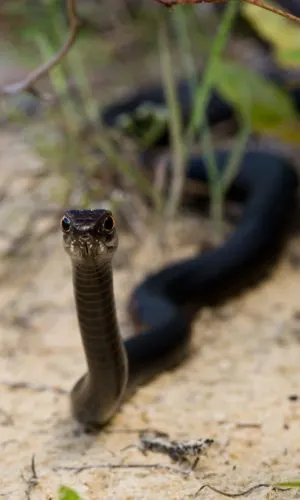
- Family: Colubridae
- Scientific Name: Coluber constrictor constrictor
- Other Names: Black Racer snake
- Adult Size: 36 to 60 inches (90 to 152 cm)
- Lifespan: 10 years
Northern Black Racers are West Virginia’s native subspecies of the Eastern Racer (Coluber constrictor). These terrestrial snakes inhabit grasslands, prairies, and other open areas as well as woodland regions that border grasslands.
Northern Black Racers are predominantly black, with gray underbellies and pale cream coloration under their chin. These snakes are fast-moving, and will race away from potential predators and can also release a defensive musk.
These diurnal hunters mainly eat small amphibians and rodents as well as smaller lizards and snakes.
12. Corn Snake
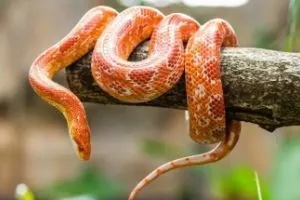
- Experience Level: Beginner
- Family: Colubridae
- Scientific Name: Pantherophis guttata
- Other Names: N/A
- Adult Size: 23.5 to 71 inches (60 to 180 cm)
- Lifespan: 6 to 8 years
- Average Price Range: $40 to $100
Named because of their tendency to stalk their rodent prey from within corn and grain stores, Corn snakes are a type of Rat snake and are rare in West Virginia. They are only found in Morgan County in the northeast. As well as barns and granaries, Corn snakes also inhabit grasslands and fields.
These beautiful snakes have tan to light brown scales with orange to red patterns that are edged in black. Corn snakes can be confused with Copperhead vipers, but lack heat-sensing pits and aren’t venomous.
These carnivorous snakes mainly eat rodents and other small mammals, but will also sometimes eat amphibians or smaller reptiles. Once they’ve matured, they can climb trees and rocky outcrops.
13. Western Rat Snake
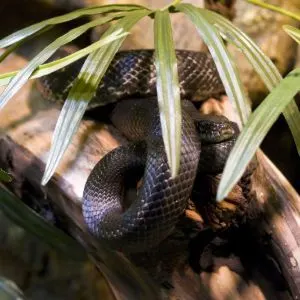
- Experience Level: Beginner to Intermediate
- Family: Colubridae
- Scientific Name: Pantherophis obsoletus
- Other Names: Black Rat snake
- Adult Size: 34 to 72 inches (85 to 180 cm)
- Lifespan: 10 to 15 years
- Average Price Range: $60 to $100
Western Rat snakes are also known as Black Rat snakes due to their dark brown to black skin coloration. They sometimes have orange or red fleck markings. Their underbellies range from cream to yellowish-green, occasionally with mottled patterns.
These impressive snakes are popular as pets, with relatively simple care requirements and agreeable temperaments for the most part. In the wild, they are usually found in open farmlands or woodlands, but can also be seen on building roofs and in trees.
Western Rat snakes climb these elevated surfaces looking for birds and their eggs to prey upon, but they will also eat rodents.
14. Northern Redbelly Snake
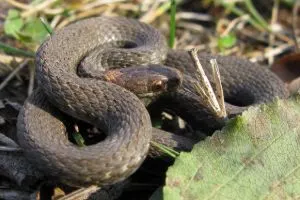
- Family: Colubridae
- Scientific Name: Storeria occipitomaculata occipitomaculata
- Other Names: Fire snake, Northern Red-bellied snake
- Adult Size: 8 to 14 inches (20 to 35 cm)
- Lifespan: 4 years
Northern Redbelly snakes are a small type of colubrid found in parts of West Virginia and are a subspecies of the Redbelly snake (Storeria occipitomaculata). They can be encountered in any garden or woodlands areas that have medium humidity.
Northern Redbelly snakes have gray to red bodies. Markings vary from broad bright colored stripes to four smaller darker stripes running down their bodies. They have a collar of markings on their necks in the form of three lightly colored dots. They have orange or red undersides.
These beautiful snakes bury themselves in the soil while hunting their preferred prey of mollusks such as earthworms, slugs, and snails. They are part of the Natricine subfamily of snakes, meaning that theyare live-bearers.
15. Northern Ringneck Snake
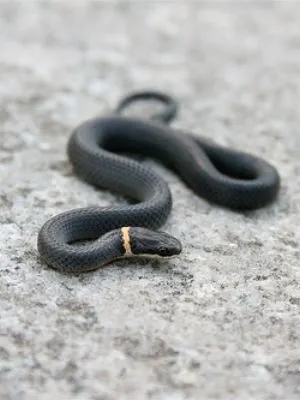
- Family: Colubridae
- Scientific Name: Diadophis punctatus edwardsii
- Other Names: Northern Ring-necked snake
- Adult Size: 10 to 15 inches (25 to 40 cm)
- Lifespan: 6 to 10 years
Northern Ringneck snakes is the subspecies of Ringneck snake found in West Virginia. This species gets its scientific name from English Ornithologist George Edwards. They can be found in humid forests and woodlands as well as wetlands and sometimes damp basements.
Northern Ringneck snakes range from black to blueish-gray in body coloration, with an orange or yellowish band looped around their necks. Their undersides are also yellowish in color. Although they are relatively small, some specimens can reach up to two feet long.
16. Northern Water Snake
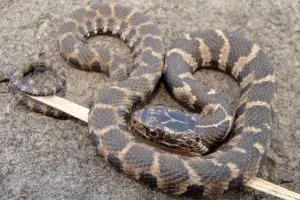
- Experience Level: Intermediate
- Family: Colubridae
- Scientific Name: Nerodia sipedon sipedon
- Other Names: Brown Water snake, Common Water snake
- Adult Size: 20 to 42 inches (50 to 105 cm)
- Lifespan: 9 to 10 years
- Average Price Range: $20 to $40
Northern Water snakes are the subspecies of Common Water snake that is native to West Virginia. These semi-aquatic serpents inhabit wetlands and reed beds along the sides of rivers and streams. They can be seen basking above the water, but will dive immediately if disturbed.
These snakes can be good pets for intermediate keepers, although most specimens are likely to be wild-caught. Northern Water snakes are light brown to black, with darker bands on their bodies. Their underbellies are a pale cream color, with dark red crescent markings.
Northern Water snakes can sometimes be mistaken for Cottonmouth vipers, but are non-venomous and harmless to humans. They can be distinguished from Cottonmouths by their flatter heads and thinner bodies. Northern Water snakes mainly eat amphibians and fish.
17. Queen Snake
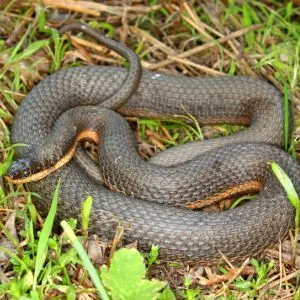
- Family: Colubridae
- Scientific Name: Regina septemvittata
- Other Names: Banded Water snake, Brown Queen snake, Queen Water snake
- Adult Size: 10 to 25 inches (25.5 to 63.5 cm)
- Lifespan: 10 to 20 years
Queen snakes are smaller Water snakes found in specific types of habitat – clean, fast-moving streams or rivers with rocky substrates. They can be confused with Garter snakes because of their similar appearance.
Queen snakes range from gray to dark brown to olive, with yellowish stripes running down their backs. Queen snakes can be distinguished from other species thanks to the dark bands running vertically down their cream or yellow underbellies. No other snake has stripes running all the way down their undersides.
These semi-aquatic colubrids are fussy eaters, feasting mainly on crayfish, which are abundant in the habitats that Queen snakes like. They prey on recently mottled crayfish that are more vulnerable.
18. Eastern Worm Snake
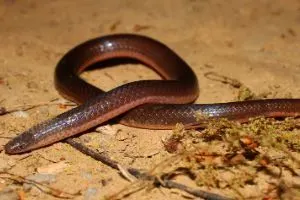
- Family: Colubridae
- Scientific Name: Carphophis amoenus amoenus
- Other Names: Worm snake
- Adult Size: 7.5 to 11 inches (20 to 30 cm)
- Lifespan: 4 to 5 years
Eastern Worm snakes are a subspecies of the Worm snake (Carphophis amoenus) found in eastern areas of the United States such as West Virginia. This fossorial species inhabits regions where wetlands and forests and woods meet.
Eastern Worm snakes range from dark brown to tan in color, with pinkish underbellies that are darker in juveniles and paler for adults. This species is small and lacks any patterns or markings on its smooth scales.
These burrowing snakes mainly consume mollusks such as earthworms, slugs, and snails. They can sometimes be found under leaf litter or rocks, but are usually pretty secretive.
That concludes the section of our list that deals with West Virginia’s non-venomous snakes. Now, we’ll take a look at the two venomous species that can be encountered in the state; the Northern Copperhead and the Timber Rattlesnake.
19. Northern Copperhead
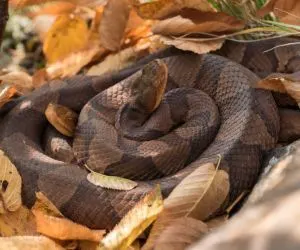
- Family: Viperidae
- Scientific Name: Agkistrodon contortrix mokasen
- Other Names: Copperhead, Copperhead Moccasin, Copper Viper
- Adult Size: 24 to 36 inches (60 to 90 cm)
- Lifespan: 15 to 18 years
Northern Copperheads are a subspecies of the Copperhead pit viper found in West Virginia. These serpents are venomous, but they toxin isn’t fatal to humans. Getting bitten is likely to cause painful swelling and nausea.
Northern Copperheads are found mainly in woodland areas where they can camouflage themselves among leaf litter. Copperheads have brown to tan bodies with darker brown band markings that resemble hourglasses. Their skin is rough, with slightly keeled scales and a heat-sensing gland between their vertical eyes and their nose. Their heads are an orange or red color.
These vipers will hide themselves under logs or in leaf litter and freeze, making them practically invisible. They mainly prey on small mammals but will also eat amphibians, insects, and lizards. They move slowly, but will quickly become more active if threatened.
20. Timber Rattlesnake
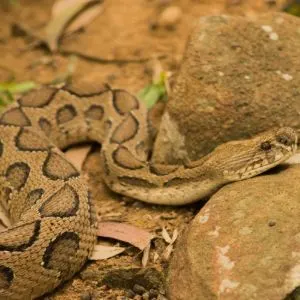
- Family: Viperidae
- Scientific Name: Crotalus horridus
- Other Names: Banded rattlesnake, Canebrake rattlesnake, Velvet Tail
- Adult Size: 35 to 55 inches (90 to 140 cm)
- Lifespan: 10 to 25 years
Timber rattlesnakes are a deadly species of viper, with a bite that is fatal to humans. If you get bitten you should get to hospital immediately. Thankfully, these rattlesnakes don’t bite often and will shake their tails for a while as a warning sign before striking.
Timber rattlesnakes inhabit woodland regions with rocky surroundings. This species has a long brumation period, which also helps to cut down on bite incidents. Timber rattlesnakes mainly prey on small mammals, but will also eat amphibians, birds, and smaller reptiles such as Garter snakes.
These deadly vipers have brown coloration, starting with golden-brown towards their heads and getting darker down the body. Their tails are almost black. They have dark band markings often ringed with orange. Timber rattlesnakes have obvious heat-sensing pits underneath their vertical eyes.
Frequently Asked Questions about West Virginia Snakes
What kind of venomous snakes are in West Virginia?
West Virginia is home to two species of venomous snake; the Northern Copperhead viper (Agkistrodon contortrix mokasen) and the Timber Rattlesnake (Crotalus horridus). While the venom of the Northern Copperhead isn’t powerful enough to kill a human, it can cause nausea and painful swelling.
Timber Rattlesnakes, however, are a different matter. Their toxin is fatal to humans, and if you get bitten then you need to go to hospital immediately. Thankfully, these snakes only bite as a last resort, so you should be safe if you keep your distance and avoid provoking them.
Does West Virginia have Cottonmouth snakes?
Cottonmouth vipers aren’t native to West Virginia. These semi-aquatic snakes are found over in Virginia, but haven’t been seen in West Virginia. The only venomous pit vipers found in West Virginia are the Northern Copperhead and the Timber Rattlesnake.
Where are Copperheads in West Virginia?
Northern Copperhead vipers are West Virginia’s only subspecies of Copperhead. They are found throughout the state in forests and areas with rocky outcrops. They prefer to hide under logs or leaf litter and are nocturnal when active in the summer. In winter months, Northern Copperheads brumate and are rarely seen.
Can you own a venomous snake in West Virginia?
It is illegal to own a venomous snake in West Virginia, unless the snake was purchased prior to June 2015. In this case, you’ll require a permit to continue owning the snake. Do not take venomous snakes, such as the Northern Copperhead or Timber Rattlesnake, from the wild.
Don’t approach these pit vipers, and it is strongly advised not to try and wrangle them. Just leave them to their own devices and you will avoid any potentially deadly bites.
Conclusion
So that wraps up our list of native snakes in West Virginia. We’ve looked at 20 types of snake in this list, with the majority of them being harmless to humans. There are only two venomous species in Virginia, and we’ve provided details to help you identify and avoid them.
Whether you use this list as a field herping guide when out on the trail, or you just want to look at it because you love snakes, we hope you enjoyed it. If you did, feel free to leave a comment down below and discuss West Virginia’s native snakes with us!
Snakes in other states
